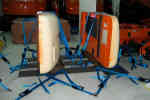Step 1 of 3•5 minutes read
The CSS Code "Rule of Thumb"
The CSS Code contains instructions on making advanced calculations when designing different cargo securing arrangements, taking all relevant factors into account. However, the CSS Code also contains a general rule of thumb, which applies to nearly any size of a ship, regardless of the location of stowage, stability and loading conditions, season, and area of operation. The rule of thumb is expressed as follows:
The total of the MSL values in tonnes of the securing devices on each side of a unit of cargo (port as well as starboard) should equal the weight of the unit in tonnes."
The rule of thumb is based on several requirements on the lashing arrangement and cargo properties. These requirements are described below.
Direct Lashings
The rule of thumb only applies to direct lashings such as straight or crossed lashings with one end connected to a fitting on the deck or a bulkhead and the other connected to a fitting on the cargo. If no lashing fittings are available on the cargo, loop lashings could be used. In that case, measures should be taken to prevent movement in the longitudinal direction.

Straight lashings securing a vehicle
Sufficient Friction
When applying the rule of thumb, adequate friction must be provided by using suitable materials. At least one of the surfaces should consist of wood or rubber. Dunnage should always be used to avoid steel-to-steel contact.

Always remember to add friction enhancing material if it is needed, at least one surface should be rubber or wood
Symmetry
Lashings should be placed symmetrically on both sides of the cargo. To provide a uniform elastic behaviour within the arrangement, all lashings should be of similar length and material. Parallel use of, for example, chain and web lashings should be avoided.

Place the lashings symmetrical
Correct Lashing Angles
Since sliding normally generates greater lashing forces than tipping movements, lashings close to parallel with the vessel's deck are more favourable than vertical lashings. Thus, when applying the rule of thumb, lashings with a vertical angle (α) towards the ship's deck larger than 60° should not be considered. Generally, cargo on board ships is subjected to greater forces in the transverse direction than in the longitudinal direction. Thus, lashings with a horizontal angle (β) towards the ship's transverse axle larger than 60° should also not be considered.

When using the rule of thumb – don't let the lashing have an angle greater than 60° towards the ship's deck

Closeup of the angles towards the ship's deck
Awkward Cargo
Tall/narrow cargoes or cargoes with a high centre of gravity, additional lashings may be required to prevent tipping. Also, for cargoes not rigid in form, the number of lashings may need to be increased compared to the rule of thumb. When cargo is stowed on the weather deck, further to the accelerations considered by the rule of thumb, it is also subjected to the wind and green sea forces. On some voyages, icing might lead to increased weight and low friction. In such cases, the number of lashings should be significantly increased.

If the cargo has an unusual shape, the rule of thumb may not apply. You might need to add lashings.
Example of the "Rule of Thumb"
The forklifts weigh 10 tonnes each. The forklifts have been secured with four web lashings with MSL 2.5 ton on each side, port as well as starboard. All lashings have acceptable lashing angles. The total MSL of the four web lashings on each side is 10 tonnes, which is equal to the weight of the units, and the cargo securing and thus complies with the rule of thumb.

Rule of thumb applied to several forklifts, each weighing 10 ton
The mobile stone crusher machinery in the picture weighs 40 tonnes. To avoid steel-to-steel contact between the caterpillar bands and the deck, rubber mats have been placed underneath the unit. Due to a high center of gravity, the vehicle must be prevented from tipping.
The machinery is secured with ten web lashings with MSL 5 ton on each side, port as well as starboard. Two lashings on each side have a vertical angle towards the ship's deck greater than 60°. These lashings prevent tipping of the machinery but should not be considered when applying the rule of thumb. The total MSL of the eight eligible web lashings on each side is 40 tonnes, which is equal to the weight of the unit, and the cargo securing arrangement thus complies with the rule of thumb.

An example of rule of thumb and a 40 ton stone crusher
Summary
If the cargo that should be secured on board is not mentioned in the vessels Cargo Securing Manual (CSM) or if a quick decision regarding the cargo securing has to be made, one simplified way to determine the number of lashings is to use the “Rule of thumb” method. This method says that the total MSL on each side of the cargo shall be equal to the weight of the cargo. There are some additional things to take into consideration, such as the contact surfaces and lashing angles. Still, as mentioned, it is a very easy and quick method to determine the required number of lashings.